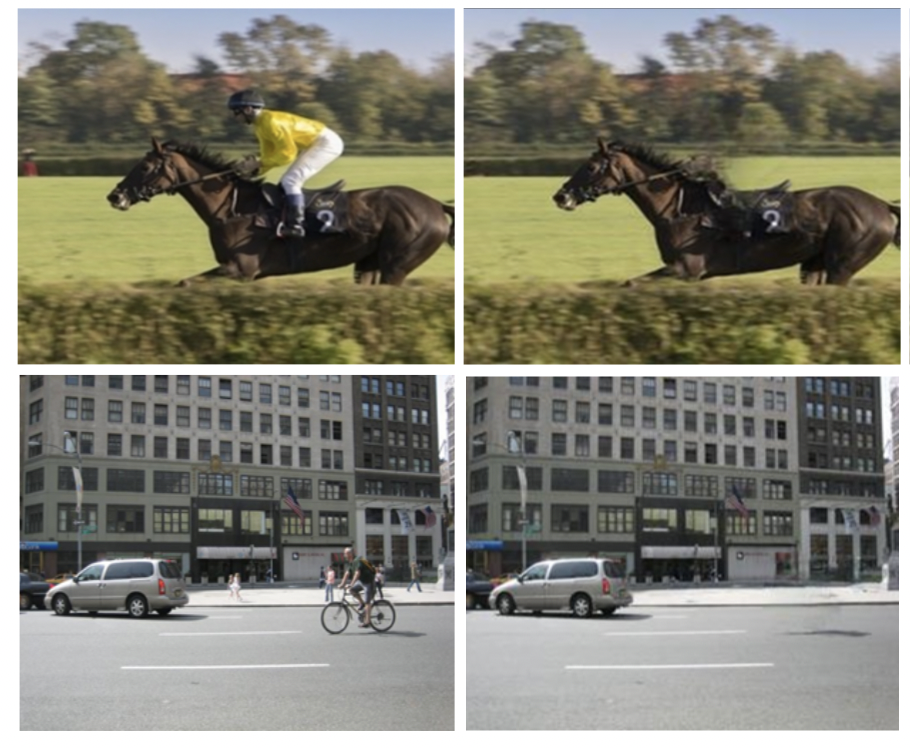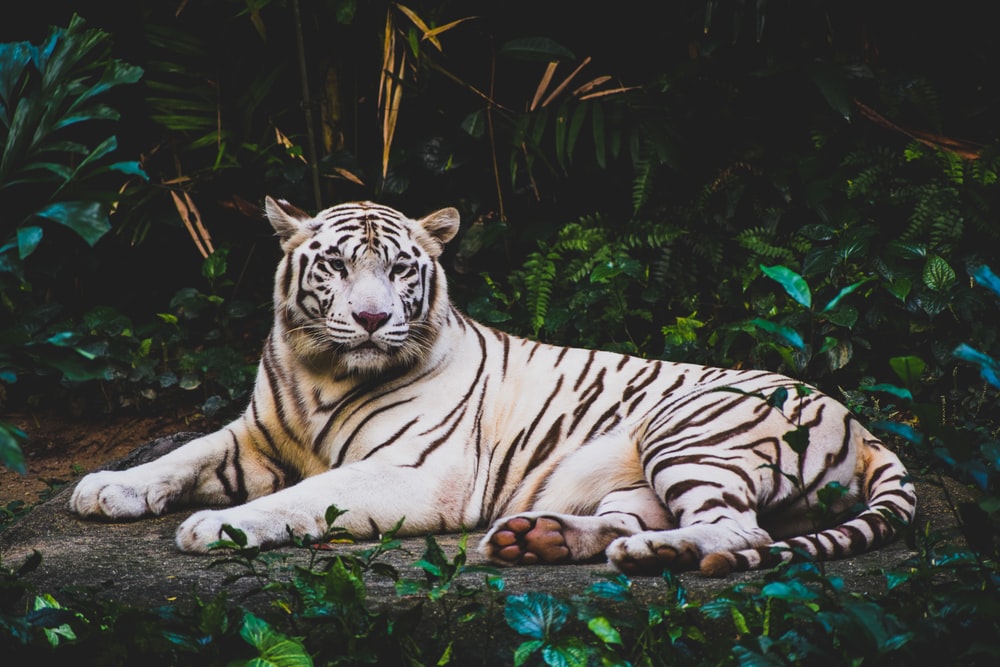object-removal
Maintainer: sujaykhandekar

15

| Property | Value |
|---|---|
| Run this model | Run on Replicate |
| API spec | View on Replicate |
| Github link | View on Github |
| Paper link | View on Arxiv |
Create account to get full access
Model overview
The object-removal model, developed by maintainer sujaykhandekar, is an AI-powered tool that can remove specified objects from images. It combines semantic segmentation and EdgeConnect architectures to identify and remove objects from photos. This model is similar to other object removal models like rembg, remove_bg, rembg, background_remover, and remove-object, which all aim to remove unwanted elements from images.
Model inputs and outputs
The object-removal model takes an image as input and a list of objects to remove. It then outputs the edited image with the specified objects removed.
Inputs
- Image Path: The path to the input image, which should ideally be a square image.
- Objects To Remove: A comma-separated list of object names to remove from the image. The model supports removing a variety of objects, including people, cars, birds, and more. See the full list of object names in the segmentation_classes.txt file.
Outputs
- Output: The edited image with the specified objects removed.
Capabilities
The object-removal model can effectively remove a wide range of objects from images, including people, animals, vehicles, and more. It uses a combination of semantic segmentation and EdgeConnect architectures to identify the objects and then inpaint the image to remove them seamlessly. The model can handle complex scenes and produce realistic results, making it a valuable tool for photo editing, data augmentation, and other applications.
What can I use it for?
The object-removal model can be used for a variety of purposes, such as:
- Photo Editing: Remove unwanted objects from your images to create clean, professional-looking photos.
- Data Augmentation: Use the model to generate additional training data for computer vision models by removing objects from images.
- Content Creation: Leverage the model to create compelling visual content by removing distracting elements from your photos.
- Background Removal: While not its primary purpose, the model can also be used to remove backgrounds from images, similar to other background removal tools.
Things to try
With the object-removal model, you can experiment with removing different combinations of objects from your images to see how the model performs. Try removing multiple objects at once, or focus on more challenging objects like complex geometric structures or overlapping elements. Additionally, you can explore using the model for data augmentation by removing objects from your training data and observing the impact on your computer vision models.
This summary was produced with help from an AI and may contain inaccuracies - check out the links to read the original source documents!
Related Models

rembg

73
The rembg model is a powerful tool for removing backgrounds from images. Developed by maintainer ilkerc, it is similar to other background removal models like background_remover, rembg, rembg-enhance, remove-bg, and remove_bg. However, rembg stands out with its high-quality results and user-friendly command-line interface. Model inputs and outputs The rembg model takes an image as input, either by file path, URL, or binary data, and outputs the same image with the background removed. It can also return only the mask, which can be useful for further post-processing. Additionally, the model supports alpha matting, which can produce more natural-looking results. Inputs Image**: The input image to have its background removed. Image URL**: The URL of the input image. Only Mask**: A boolean flag to return only the mask, without the foreground object. Alpha Matting**: A boolean flag to use alpha matting for a more natural-looking result. Outputs Output Image**: The input image with the background removed. Capabilities The rembg model can remove backgrounds from a wide variety of images, including photographs of people, animals, vehicles, and even anime characters. The model is generally accurate and can handle complex backgrounds, although it may struggle with some intricate details or fine edges. What can I use it for? The rembg model is a versatile tool that can be used in a variety of applications, such as: Product photography**: Removing backgrounds from product images to create clean, professional-looking assets. Social media content**: Isolating subjects in images to create engaging visuals for social media platforms. Creative projects**: Extracting subjects from images to use in digital art, photo manipulation, and other creative endeavors. E-commerce**: Automating the process of removing backgrounds from product images to streamline online store operations. Things to try One interesting thing to try with the rembg model is using it in combination with other image processing techniques, such as image segmentation or object detection. By combining these tools, you can create more advanced workflows that allow for even greater control and customization of the background removal process. Another idea is to experiment with the different pre-trained models available, including u2net, u2netp, u2net_human_seg, and u2net_cloth_seg. Each of these models has been optimized for specific use cases, so you may find that one works better than others depending on the type of images you're working with.
Updated Invalid Date

remove-object

170
The remove-object model is an advanced image inpainting system designed to address the challenges of handling large missing areas, complex geometric structures, and high-resolution images. It is based on the LaMa (Large Mask Inpainting) model, which is an innovative image inpainting system that uses Fourier Convolutions to achieve resolution-robust performance. The remove-object model builds upon this foundation, providing improved capabilities for removing unwanted objects from images. Model inputs and outputs The remove-object model takes two inputs: a mask and an image. The mask specifies the areas of the image that should be inpainted, while the image is the source image that will be modified. The model outputs a new image with the specified areas inpainted, effectively removing the unwanted objects. Inputs Mask**: A URI-formatted string representing the mask for inpainting Image**: A URI-formatted string representing the image to be inpainted Outputs Output**: A URI-formatted string representing the inpainted image Capabilities The remove-object model is capable of seamlessly removing a wide range of objects from images, including complex and irregularly shaped ones. It can handle large missing areas in the image while maintaining the overall structure and preserving important details. The model's advanced algorithms ensure that the inpainted regions blend naturally with the surrounding content, making the modifications virtually indistinguishable. What can I use it for? The remove-object model can be a powerful tool for a variety of applications, such as content-aware image editing, object removal in photography, and visual effects in media production. It can be used to clean up unwanted elements in photos, remove distractions or obstructions, and create more visually appealing compositions. Businesses can leverage this model to enhance their product images, remove logos or watermarks, or prepare images for use in marketing and advertising campaigns. Things to try Experimentation with the remove-object model can reveal its versatility and uncover new use cases. For example, you could try removing small or large objects from various types of images, such as landscapes, portraits, or product shots, to see how the model handles different scenarios. Additionally, you could explore the model's ability to preserve the overall image quality and coherence, even when dealing with complex backgrounds or intricate object shapes.
Updated Invalid Date

rembg

9
rembg is an AI model that removes the background from images. It is maintained by abhisingh0909. This model can be compared to similar background removal models like background_remover, remove_bg, rembg-enhance, bria-rmbg, and rmgb. Model inputs and outputs The rembg model takes a single input - an image to remove the background from. It outputs the resulting image with the background removed. Inputs Image**: The image to remove the background from. Outputs Output**: The image with the background removed. Capabilities The rembg model can effectively remove the background from a variety of images, including portraits, product shots, and more. It can handle complex backgrounds and preserve details in the foreground. What can I use it for? The rembg model can be useful for a range of applications, such as product photography, image editing, and content creation. By removing the background, you can easily isolate the subject of an image and incorporate it into other designs or compositions. Things to try One key thing to try with the rembg model is experimenting with different types of images to see how it handles various backgrounds and subjects. You can also try combining it with other image processing tools to create more complex compositions or visual effects.
Updated Invalid Date

propainter

2
ProPainter is an AI model developed by researchers at the S-Lab of Nanyang Technological University for object removal, video completion, and video outpainting. The model builds upon prior work on video inpainting like xmem-propainter-inpainting and object-removal, with improvements to the propagation and transformer components. ProPainter can be used to seamlessly fill in missing regions in videos, remove unwanted objects, and even extend video frames beyond their original boundaries. Model inputs and outputs ProPainter takes in a video file and an optional mask file as inputs. The mask can be a static image or a video, and it specifies the regions to be inpainted or outpainted. The model outputs a completed or extended video, addressing the specified missing or unwanted regions. Inputs Video**: The input video file to be processed. Mask**: An optional mask file (image or video) indicating the regions to be inpainted or outpainted. Outputs Completed/Extended Video**: The output video with the specified regions filled in or extended. Capabilities ProPainter excels at both object removal and video completion tasks. For object removal, the model can seamlessly remove unwanted objects from a video while preserving the surrounding context. For video completion, ProPainter can fill in missing regions caused by occlusions or artifacts, generating plausible content that blends seamlessly with the original video. What can I use it for? The ProPainter model can be useful for a variety of video editing and post-production tasks. For example, you could use it to remove unwanted objects or logos from videos, fill in missing regions caused by camera obstructions, or even extend the boundaries of a video to create new content. These capabilities make ProPainter a valuable tool for filmmakers, video editors, and content creators who need to enhance the quality and appearance of their video footage. Things to try One interesting aspect of ProPainter is its ability to perform video outpainting, where the model can extend the video frames beyond their original boundaries. This could be useful for creating cinematic video expansions or generating new content to fit specific aspect ratios or dimensions. Additionally, the model's memory-efficient inference features, such as adjustable neighbor length and reference stride, make it possible to process longer videos without running into GPU memory constraints.
Updated Invalid Date